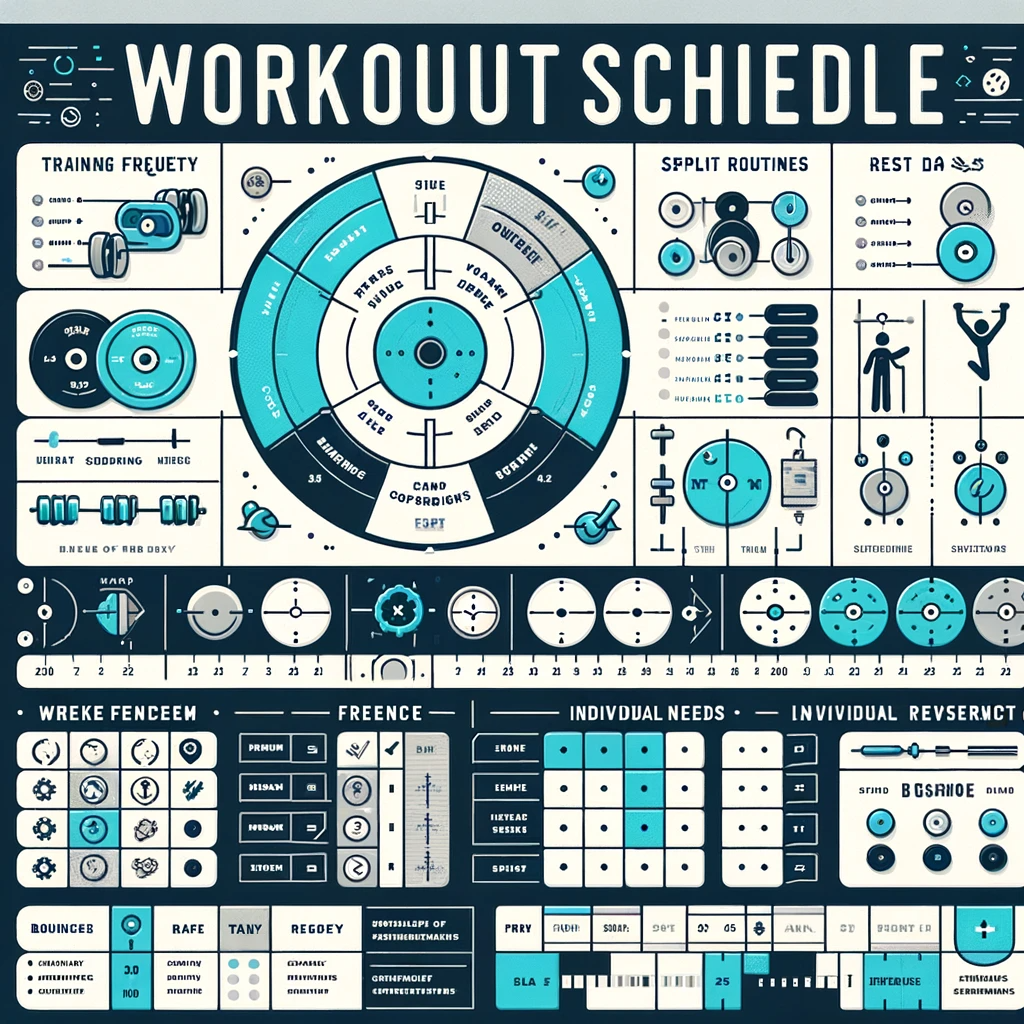Creating a workout schedule that is both effective and tailored to your goals can be a daunting task. With so much information available, it’s easy to get overwhelmed and unsure of where to start. Here, we’ll break down the key factors to consider when designing your training schedule to ensure optimal results. By the end, you’ll have a clear understanding of how to structure your workouts and maximize your gains.
Decoding Your Training Schedule
Before diving into the specifics of training frequency and split routines, it’s important to understand the basics of designing a workout schedule. A well-designed schedule should take into account your individual needs, preferences, and lifestyle. It should provide a balance between challenging your body and allowing sufficient time for recovery.
When it comes to designing a training schedule, there are several factors to consider. These include your training frequency, the science behind effective training, and finding the perfect balance between intensity and volume.
Finding the Perfect Training Frequency for You

The frequency at which you train plays a crucial role in determining the effectiveness of your workouts. Training too frequently can lead to overtraining and increased risk of injury, while training too infrequently may not provide enough stimulus for progress. To find the perfect training frequency for you, consider factors such as your training experience, goals, and recovery capacity.
For beginners, starting with 2-3 full-body workouts per week is often a good starting point. This allows for sufficient recovery between sessions while providing enough stimulus for progress. As you advance, you can gradually increase the frequency to 4-6 sessions per week, depending on your goals and recovery ability.
It’s important to listen to your body and adjust your training frequency accordingly. If you find that you’re constantly fatigued or experiencing persistent muscle soreness, it may be a sign that you need to decrease your training frequency and allow for more recovery time.
The Science Behind Effective Training
To design an effective workout schedule, it’s essential to understand the science behind training. Different training variables, such as intensity, volume, and exercise selection, elicit varying responses in the body. By manipulating these variables strategically, you can optimize your workouts for maximum results.
Intensity refers to the level of effort exerted during a workout. It can be measured by factors such as load, speed, or perceived exertion. Increasing intensity can elicit greater adaptations in strength and muscle growth. However, it’s important to progress gradually to avoid overexertion or injury.
Volume, on the other hand, refers to the total amount of work performed in a given session or week. It is typically measured by the number of sets and reps performed. Gradually increasing volume over time can lead to greater muscular endurance and hypertrophy. However, it’s crucial to find a balance between pushing your limits and allowing adequate recovery.
Exercise selection is another important aspect of effective training. Different exercises target different muscle groups and movement patterns. Incorporating a variety of exercises into your training routine can help prevent muscle imbalances and keep your workouts interesting and engaging.
Additionally, rest and recovery are essential for optimal training results. Giving your body enough time to rest and repair between workouts allows for muscle growth and prevents overuse injuries. It’s important to prioritize sleep, nutrition, and stress management to support your body’s recovery process.
By understanding the science behind effective training and manipulating training variables in a strategic manner, you can design a workout schedule that maximizes your results and helps you reach your fitness goals.
Maximizing Gains with Strategic Training Splits

Training splits refer to the division of muscle groups or movements into separate workouts. This approach allows for greater focus and intensity on specific muscle groups or movement patterns. By strategically organizing your workouts, you can target each muscle group effectively and optimize muscle growth.
When it comes to muscle building, there are several popular training splits that have been proven effective. The choice of split depends on factors such as training experience, available time, and personal preferences. Let’s explore some of the most commonly used training splits:
- The Push-Pull-Legs Split: This split divides workouts into pushing exercises (e.g., chest and triceps), pulling exercises (e.g., back and biceps), and leg exercises. It allows for adequate recovery between muscle groups while providing a balanced approach to training.
- The Upper-Lower Split: This split alternates between upper-body and lower-body workouts. It allows for more frequent training of each muscle group while still allowing sufficient recovery. This split is especially popular among intermediate and advanced lifters.
- The Bro-Split: This split typically involves training each muscle group once per week. While it may not be the most optimal for muscle growth, it can still be effective for beginners or those with limited time availability.
Regardless of the training split you choose, it’s important to structure your workouts in a way that ensures progressive overload and targets all major muscle groups. Here are some key tips:
- Start each workout with compound exercises that target multiple muscle groups. This allows you to lift heavier weights and stimulates overall muscle growth.
- Include a mix of compound and isolation exercises to target both large and small muscle groups.
- Vary your rep ranges to stimulate different types of muscle fibres. This can be achieved by incorporating both heavy, low-rep sets and moderate to high-rep sets.
- Allow for adequate rest between sets to maintain proper form and intensity.
- Periodize your training by incorporating different training phases, such as strength-focused, hypertrophy-focused, and deload phases. This helps prevent plateaus and promotes continued progress.
Additionally, it’s important to consider the concept of muscle confusion. While following a specific training split can be effective, it’s also beneficial to periodically change your routine to keep your muscles guessing and prevent adaptation. This can be done by altering the exercises, rep ranges, or training frequency.
Another factor to consider is the importance of nutrition and recovery. To maximize muscle growth, it’s essential to consume a balanced diet that provides adequate protein, carbohydrates, and fats. Additionally, getting enough rest and sleep is crucial for muscle repair and growth.
Furthermore, incorporating proper warm-up and cool-down routines into your workouts can help prevent injuries and improve overall performance. Dynamic stretching, foam rolling, and mobility exercises are all effective ways to prepare your body for exercise and promote flexibility.
Lastly, tracking your progress is key to ensuring that you are making gains and achieving your goals. Keeping a workout journal or using a fitness app can help you monitor your lifts, track your progress, and make adjustments to your training program as needed.
By implementing these strategies and paying attention to the details of your training program, you can maximize your gains and achieve the results you desire. Remember, consistency and dedication are key, so stay committed to your training and enjoy the journey towards a stronger, more muscular physique!
Unleashing Muscle Growth Potential: Backed by Research
While training frequency and split routines are important considerations in designing an effective workout schedule, other factors can also significantly impact muscle growth. To optimize your results, it’s essential to have a comprehensive understanding of evidence-based strategies backed by research.
When it comes to building muscle, there are several evidence-based strategies that can enhance muscle growth and maximize the effectiveness of your workouts. These strategies have been extensively studied and proven to yield positive results.
Evidence-Based Strategies for Optimal Muscle Growth
Research has identified several strategies that can enhance muscle growth and maximize the effectiveness of your workouts:
- Progressive Overload: Continuously challenge your muscles by progressively increasing the intensity, volume, or difficulty of your workouts. This can be achieved by adding more weight, performing more repetitions, or incorporating advanced techniques such as drop sets or supersets.
- Nutrient Timing: Consuming an adequate amount of protein and carbohydrates before and after your workouts can support muscle repair and growth. Pre-workout nutrition provides the necessary fuel for your muscles, while post-workout nutrition replenishes glycogen stores and aids in muscle recovery.
- Proper Recovery: Allow sufficient rest and recovery between workouts to promote muscle repair and prevent overtraining. Adequate rest periods allow your muscles to recover and adapt to the stress imposed during exercise, leading to muscle growth.
- Sleep Quality: Aim for 7-9 hours of quality sleep each night to support muscle recovery and overall well-being. During sleep, your body releases growth hormone, which plays a crucial role in muscle repair and growth. Lack of sleep can hinder muscle recovery and impair performance.
- Consistency: Consistently follow your workout schedule and stay committed to your training routine for long-term progress. Building muscle takes time and consistency is key. Stick to your plan and make adjustments as needed to continue challenging your muscles.
By incorporating these evidence-based strategies into your workout routine, you can optimize your muscle growth potential and achieve better results.
The Role of Nutrition in Maximizing Muscle Gain
An effective workout schedule goes hand in hand with proper nutrition. To maximize muscle gain, it’s important to consume a balanced diet that provides adequate calories, macronutrients, and micronutrients.
When it comes to nutrition for muscle growth, protein is a crucial macronutrient. It provides the building blocks (amino acids) necessary for muscle repair and growth. Aim to consume high-quality protein sources such as lean meats, poultry, fish, eggs, dairy products, and plant-based protein options.
In addition to protein, carbohydrates play a vital role in providing energy for your workouts. They replenish glycogen stores, which are depleted during exercise, and provide a readily available fuel source for your muscles. Opt for complex carbohydrates like whole grains, fruits, and vegetables to fuel your workouts and support overall health.
Healthy fats are also important for muscle growth and overall well-being. They provide essential fatty acids that support hormone production and aid in nutrient absorption. Incorporate sources of healthy fats such as avocados, nuts, seeds, and olive oil into your diet.
Hydration is often overlooked but is essential for optimal muscle function. Aim to drink enough water throughout the day to stay hydrated, especially during and after your workouts. Proper hydration supports nutrient delivery to your muscles and helps prevent muscle cramps and fatigue.
Supplements can also be a valuable addition to your nutrition plan. While they are not a substitute for a balanced diet, certain supplements can support your training goals. Consult with a healthcare professional or registered dietitian to determine which supplements may be beneficial for you.
Designing an effective workout schedule can be a challenging process, but it’s worth the effort to achieve optimal results. By understanding the principles outlined in this guide and tailoring them to your individual needs, you can design a schedule that maximizes your gains and helps you reach your fitness goals. Remember, consistency and patience are key, so stay committed to your training and enjoy the journey towards a stronger and healthier you!

